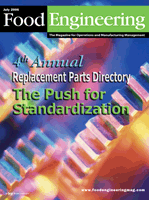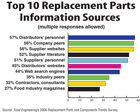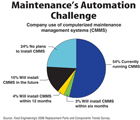

The fourth annual study of food and beverage personnel involved in spare parts ordering posed the open-ended question, "What actions could OEMs take to make you a more satisfied customer?" Predictably, lower prices were the most frequently mentioned way to buyers' hearts, though rock-bottom pricing isn't what they have in mind. In fact, lowest price was the least important of 11 considerations when selecting a parts supplier. Cost usually was pared with another factor in the written comments. "Cost reductions, service plans, better deliveries, responsiveness, commercial equivalent parts," are on the wish list of one respondent.
"Lower part pricing, and make parts more standard," wrote another, a sentiment that captured the mood of more than a few food manufacturers. "Use standard parts that can be purchased directly off the shelf without specialty ordering from an OEM," was another blunt message that resonated withFood Engineeringreaders. And if an OEM part absolutely must be used, is it too much to expect easy access to a part number, many wanted to know.
Parts availability can escalate to a crisis situation if it means the difference between production and downtime, and the comment, "better service and 24-hour parts availability," summarized the feelings of many. "Stock product locally," demanded one respondent. "Stock more parts in the US," cried another, a complaint linked to the staggered march in the globalization of supply chains.
Parts manufacturers and distributors could do a better job of making accurate and timely information available, regardless of what media they use. "Better search engines, data inside websites, faster response," one respondent wrote. "Better-quality service manuals, real-time repair and replace, better mean-time-to-failure rate levels," added another. Whether they use web-based tools or paper-and-ink manuals, suppliers need to up their game when it comes to detailed information.
Well-trained service personnel also would be appreciated. And while they're at it, how about designing and supplying parts customers actually want? "Carry inventory, research solutions to problems, ask the customer about parts issues," an end-user pointedly suggests. "When building the equipment," adds another, "let us decide the brand of drives to install and the power transmission [to use]."

Proactive vs. reactive maintenance
Year-to-year comparisons are difficult to make because of a changing base of respondents and other factors. This year's survey drew feedback from professionals at smaller plants, for example: 26 percent worked at facilities with 500 or more employees, compared to 32 percent in 2005's survey. Average spending on replacement parts and components was $2,264,485, less than half last year's average of $4.9 million.Regardless of plant size or budgeted spending, the trend away from run-to-failure maintenance continues. Only one in five respondents report their companies are sticking with that approach, a higher rate than large plants, but still well below the 26 percent with remedial maintenance in 2003's survey. Regularly scheduled visual inspections remain the most popular strategy, with 56 percent employing it. Ongoing scheduled parts replacement is common at 12 percent of plants, followed by automated measurement and monitoring at 5 percent. Predictive tools such as energy use and vibration monitoring are used by one in 25.

Parts selection is a collaborative effort in most organizations, though the maintenance staff continues to play a key role. Given a list of nine job functions, survey respondents were asked to indicate which were involved in five decision stages, from determining need to placing an order. Maintenance determined need three-quarters of the time, and engineering developed order specifications three-fifths of the time. Maintenance was involved in evaluating and recommending replacements 70 percent of the time, with engineers not far behind at 58 percent. Administrators or executives got involved in purchase approval 63 percent of the time, with plant operations, maintenance and engineering each involved in about two-fifths of the calls. Purchasing placed two-thirds of the orders, with maintenance involved in half. IT (73%), R&D (57%) and outside contractors (64%) were not involved in the decision process at most companies, though contractors' recommendations or evaluations were a factor in almost one-quarter of the decisions.

When trolling for parts information, industry professionals put more credence in supplier websites (56%) than distributor sites (45%), though that could be a function of availability. Distributors' sales and customer service personnel were the leading source of information (57%), while supplier personnel ranked fifth (51%).
Outsourced parts management is a growing trend. While dollar-value of inventory (69%) and inventory turns (55%) remain the most prevalent methods of inventory-management tracking, almost three in 10 (29%) are outsourcing the job to local supply houses. Vendor-managed parts inventory (44%) grew to the second most popular inventory-management practice, trailing only remanufactured or re-engineered parts (50%).

Product quality, on-time delivery, product availability and speed of delivery ranked as the top considerations when selecting a supplier, with virtually all respondents ranking them as somewhat, very or extremely important. Only one percent rated value for price paid as not particularly important; in contrast, 18 percent rated lowest price as not very important, and another two percent indicated it was not at all important.
If fast delivery of a critical part is necessary, 62 percent of plants request or recommend UPS service, slightly more than FedEx (59%). DHL was a distant third (22%), with 18 percent indicating other services or no preference.
Sidebar:
Who responded to this survey
Food manufacturing professionals involved in purchasing more than $566 million worth of replacement parts and components provided input into this year's trend study. Mailed surveys were sent in February to 2,500Food Engineeringsubscribers, with a 10 percent response rate.Almost half the responses came from engineers and plant operations professionals. Administrators and executives (21%) and maintenance managers (19%) accounted for most of the rest. Other job functions included purchasing, quality assurance, R&D and IT.
Meat, poultry and seafood processing was the manufacturing focus at a fifth of the respondents' facilities, followed by dairy (14%), canned and frozen produce (14%), beverages (9%) and bakery products (9%). Almost two-thirds of respondents' plants have 100 to 499 employees. Fourteen percent of respondents work at facilities with 1,000 or more employees while 11 percent work at locations with fewer than 100 employees.